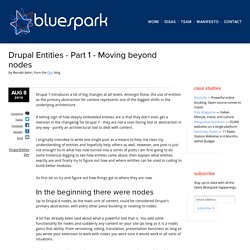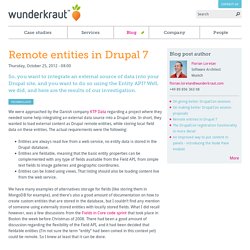

Connecting your Drupal site to a Microsoft Active Directory server. Drupal has become a hugely popular framework for building big websites and is becoming more and more widely used in government and public sector.

The likelihood of these organisations wanting to offer SSO to their users is pretty big also. The Drupal Lightweight Directory Access Protocol or “LDAP” module allows, for organisations that hold their user data in an Active Directory installation, their users to login to the Drupal site using those credentials. The setup of an Active Directory instance is a little outside the scope of this blogpost but there is a fantastic knowledge base article by Rackspace that guides you through the setup perfectly ( The configuration screen (found at admin/config/people/ldap) is split into a number of tabs. We will firstly be concerned with “Server”, this tab allows us to define our connection credentials to our Active Directory instance. Connection Settings After the server connection details are entered, this is where things get a little more complicated. This is a cheat sheet and rough guide to the integration of Drupal and Apache Solr. It will contain useful functions and how to combine them, a basic layout on how the components fit together, and some DOs and DON'Ts. All of this is based on the [apacheso.
Drops-7/modules/pantheon/pantheon_apachesolr at master · pantheon-systems/drops-7. Apache Solr and External (non-Drupal) Content. In a recent project, we had some non-Drupal content that needed to be indexed so we could expose that content to the apachesolr module for indexing with all the rest of Drupal created content.

There are several options to do this, including crawling using nutch. However in our case, the content is grabbed as xml content from a web service. We already ha an xslt transform to convert it into html content to embed in the site. In effect, we already had the raw content and knew all the "entity ids" so we didn't need to crawl. Our problem became, "What is the best way to take the title and body text of these documents and throw them in the direction of solr". This solution is very extensible. The final step is to drive everything with a drush script. Techniques To Improve Your Solr Search Results. Solr is a tremendously popular option for providing search functionality in Drupal.

While Solr provides pretty good default results, making search results great requires analysis of what your users search for, consideration of which data is sent to Solr, and tuning of Solr’s ‘boosting’. In this post, I will show you a few techniques that can help you leverage Solr to produce great results. I will specifically be covering the Apache Solr Search module. Similar concepts exist in the Search API Solr Search module, but with different methods of configuring boosting and altering data sent to Solr. HOWTO: Upgrade an SVN Managed Drupal Installation (without CVS) Explaining architectural tiers in Drupal – robknight.org.uk. Like most web frameworks, Drupal has three easily-identifiable architectural layers: Data, including the DB abstraction layer and some contrib modules such as ViewsLogic, consisting mostly of module codePresentation, representing by the theme layer When thinking about Drupal, it’s therefore pretty easy to apply some familiar (outside of Drupal-world) concepts and principles.

And the three-tier architecture is popular precisely because it’s a good model that is widely applicable. The three-tier approach can easily become the MVC model, which most other web frameworks explicitly adopt as their fundamental architecture, though the variation in quality of these “MVC” frameworks suggests that they don’t always adopt it correctly. So, at a trivial level, it’s possible to describe Drupal as having a three-tier architecture. The Presentation-Abstraction-Control model (or Hierarchical MVC) As an example, consider a Drupal page which contains some blocks.
Modules are Vertical, not Horizontal.
Drupal Entities - Part 1 - Moving beyond nodes. Drupal 7 introduces a lot of big changes at all levels.

Amongst these, the use of entities as the primary abstraction for content represents one of the biggest shifts in the underlying architecture. Remote entities in Drupal 7. We were approached by the Danish company KTP Data regarding a project where they needed some help integrating an external data source into a Drupal site.

In short, they wanted to load external content as Drupal remote entities, while storing local field data on these entities. The actual requirements were the following: Entities are always read live from a web service, no entity data is stored in the Drupal database.Entities are fieldable, meaning that the basic entity properties can be complemented with any type of fields available from the Field API, from simple text fields to image galleries and geographic coordinates.Entities can be listed using views. That listing should also be loading content live from the web service. Warning. Drupal 6 to 7 migration guide. Quick install Drupal with XAMPP on Windows.